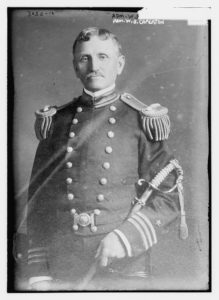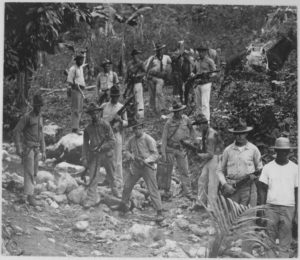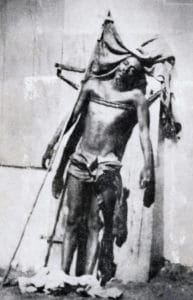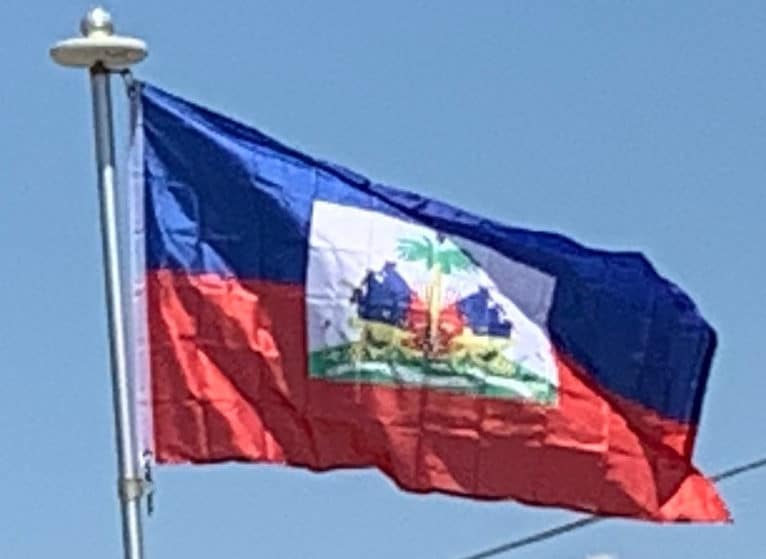In 1915, Haiti’s new President Vilbrun Guillaume Sam sought to strengthen his tenuous rule by a mass execution of 167 political prisoners. Outrage at the killings led to riots, and Sam was captured and killed by a lynch mob. Fearing possible foreign intervention, or the emergence of a new government led by the anti-American Haitian politician Rosalvo Bobo, President Woodrow Wilson sent U.S. Marines into Haiti in July 1915. The USS Washington, under Rear Admiral Caperton, arrived in Port-au-Prince in an attempt to restore order and protect U.S. interests.

Within days, the Marines had taken control of the capital city and its banks and customs house. The Marines declared martial law and severely censored the press. Within weeks, a new pro-U.S. Haitian president, Philippe Sudré Dartiguenave, was installed and a new constitution written that was favorable to the interests of the United States. The constitution (written by future US President Franklin D. Roosevelt) included a clause that allowed, for the first time, foreign ownership of land in Haiti, which was bitterly opposed by the Haitian legislature and citizenry.

The occupation greatly improved some of Haiti’s infrastructure and centralized power in Port-au-Prince. Infrastructure improvements were particularly impressive: 1700 km of roads were made usable, 189 bridges were built, many irrigation canals were rehabilitated, hospitals, schools, and public buildings were constructed, and drinking water was brought to the main cities. Port-au-Prince became the first Caribbean city to have a phone service with automatic dialling. Agricultural education was organized, with a central school of agriculture and 69 farms in the country. However many infrastructure projects were built using the corvée system that allowed the government/occupying forces to take people from their homes and farms, at gunpoint if necessary, to build roads, bridges etc. by force, a process that was deeply resented by ordinary Haitians. Sisal was also introduced to Haiti, and sugarcane and cotton became significant exports, boosting prosperity. Haitian traditionalists, based in rural areas, were highly resistant to U.S.-backed changes, while the urban elites, typically mixed-race, welcomed the growing economy, but wanted more political control. Together they helped secure an end to the occupation in 1934, under the Presidency of Sténio Vincent (1930–41). The debts were still outstanding, though less due to increased prosperity, and the U.S. financial advisor-general receiver handled the budget until 1941.
The U.S. Marines were instilled with a special brand of paternalism towards Haitians “expressed in the metaphor of a father’s relationship with his children.” Armed opposition to the US presence was led by the cacos under the command of Charlemagne Péralte; his capture and execution in 1919 earned him the status of a national martyr.

During Senate hearings in 1921, the commandant of the Marine Corps reported that, in the 20 months of active unrest, 2,250 Haitians had been killed. However, in a report to the Secretary of the Navy, he reported the death toll as being 3,250. Haitian historians have claimed the true number was much higher. One went so far as to say, “the total number of battle victims and casualties of repression and consequences of the war might have reached, by the end of the pacification period, four or five times that – somewhere in the neighborhood of 15,000 persons.” This is not supported by most historians outside Haiti.
Post-Occupation Era (1934–1957):
After US forces left in 1934, Dominican dictator Rafael Trujillo used anti-Haitian sentiment as a nationalist tool. In an event that became known as the Parsley Massacre, he ordered his army to kill Haitians living on the Dominican side of the border. Few bullets were used – instead, 20,000–30,000 Haitians were bludgeoned and bayonetted, then herded into the sea, where sharks finished what Trujillo had begun. Congressman Hamilton Fish, ranking member of the House Foreign Affairs Committee, called the Parsley Massacre “the most outrageous atrocity that has ever been perpetrated on the American continent.”
